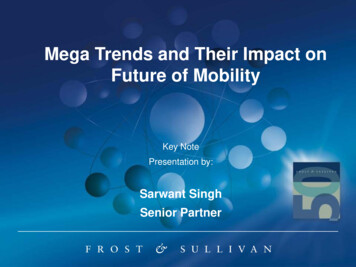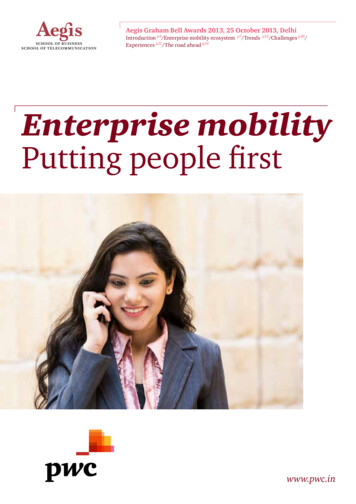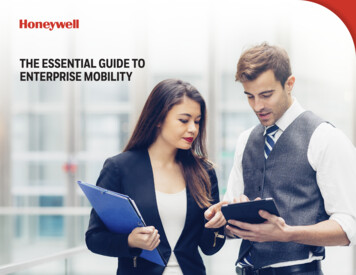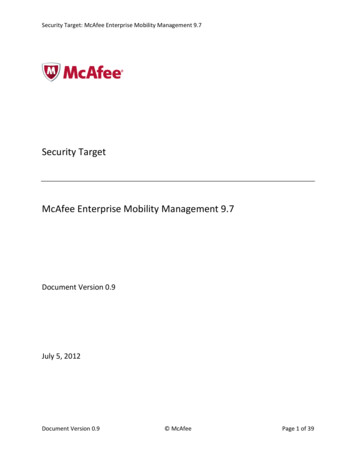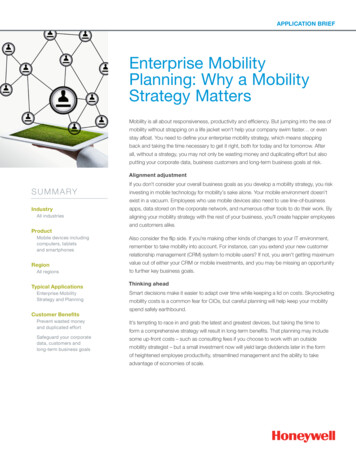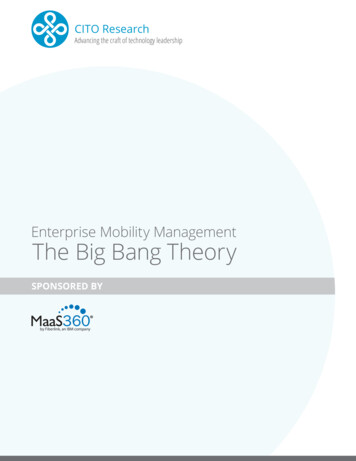
Transcription
CITO ResearchAdvancing the craft of technology leadershipEnterprise Mobility ManagementThe Big Bang TheorySPONSORED BYby Fiberlink, an IBM company
CONTENTSIntroduction 1The Mobility Explosion: The Big Bang That Keeps Expanding 1Enterprise Mobility Management:For Today’s Mobile Universe, and What’s Next 4The Final Frontier 5Managing an Ever Expanding Universe with Ease 6Enterprise Mobility Management: At Last a Comprehensible Cosmos Conclusion 79
Advancing the craft of technology leadershipIntroductionThe boundaries between working “in the office,” “on the road,” or “at home” have been blurredby the untethered power of smartphones, tablets, and other portable devices. Employeesexpect the flexibility to work on the devices they choose, and employers have come to expect always-on availability. That business requirement often conflicts with those in charge ofsecuring corporate networks and data. In some organizations, this has led to the draconiananswer “no.” But today those responses are few and far between. The norm today is, “Itdepends.” One also can’t forget the microcosm of different departments within an organization, which yet again causes great debate on how much access is needed, balanced againsthow to protect sensitive data.Enterprise Mobility Management The Big Bang TheoryCITO ResearchTo maximize mobility, a nuanced strategy is the order of the day. For mobility’s transformative potential to be realized, IT needs to become a business partner that understandsbusiness drivers and then devises the technology roadmap to support everyone’s goals.The universe of mobility is a complex thing, and it is ever-expanding—much like our actualuniverse. The other similarity mobility shares with our ever-expanding cosmos is the potential that can be realized through a rational, analytic, and comprehensive understanding.The Mobility Explosion:The Big Bang That Keeps ExpandingIn the beginning there was darkness, especially for those who needed to get work done onthe road or at home. Workers left their data and productivity programs on their cumbersome desktops. Laptops made it possible to work outside the office, but connectivity wascostly and inconsistent. Also, the minute you closed your laptop, you entered an informationblack hole of nothingness.With the arrival of BlackBerry, people in corporate leadership became connected to theiroffice. There was light, but it was more like faraway stars in a dark night sky than a beaconof brightness.Then, in a white-hot burst of innovation, came the first smartphone.The light spread, as did the devices, to people of all kinds. Executives had BlackBerries, butsuddenly new touch-based devices with iOS and Android operating systems started to enterpeople’s pockets and their workplace.1
Advancing the craft of technology leadershipThen—another bang—the tablet arrived, with larger screens that enabled even more workand play. Their larger size and increased intelligence finally made data retrieval and manipulation on the move a reality. The workers became enlightened, but their guardians inIT remained in the shadows, unconvinced. What devices should connect to corporate resources? Which should not? What was safe?Managing the Big Bang of MobilityHow could the Big Bang of mobility be managed?Managing DevicesEnter Mobile Device Management (MDM), the nucleus of IT’s BigDevicesBang point solution for being able to gain visibility and apply somemanaged bycontrols. In this universal expansion, MDM gave IT the ability toexternal serviceenforce a passcode, connect to corporate resources such as emailproviders estimatedand WiFi networks, and monitor devices.to grow overThrough APIs built into the operating system, IT could configuresettings, enable or disable features, locate and lock devices remotely and even partially or fully wipe data when necessary.Enterprise Mobility Management The Big Bang TheoryCITO Research50%in 2013 1GartnerIT declared this to be good, and the people mostly agreed. But as users and apps becamemore sophisticated, and documents such as spreadsheets and Word docs became manipulable on mobile devices, many companies found they needed more than just MDM.In response to this plea, there came another expansion—the advent of solutions for app andcontent management and the separation of work and personal in the form of containers.Managing AppsMobile Application Management (MAM), as the name implies, focused on the lifecycleaspects such as distribution, updates, enterprise app catalogs, blacklisting/whitelisting, andsecurity. MAM was needed to manage the exploding universe of public and custom apps.But applications are not “one size fits all”—some are not written or owned by the enterprise—so the ability to control them would always be limited. One ideal application for MAMis controlling a device dedicated to a single app in what has sometimes been dubbed “KioskMode.” Use cases in retail stores and hotels have enabled this mode to expedite the check-inprocess, look up inventory, or order food and ints.do?id 1-1HTJHYV&ct 130730&st sb2
Advancing the craft of technology leadershipManaging ContentAgain, the universe expanded. In a burstof light the people were given Mobile Content Management (MCM). Now, files anddocuments could be shared selectively withthe right members of a team. Some peoplehave permission to see some documents,forward them, but not others. Some canedit the documents and save theirchanges back to the file sharefor all to see and sync themacross their devices. MCMof IT Managers’brought this kind of engreatest security concernsablement and control tostem from connectingenterprise mobility. Thepersonal devices to thefuture also held hopecorporate network 2and promise—the poPonemon Institutetential for secure, private,simultaneous collaborativeediting of shared documents on66%mobile devices without worry of collidinginto rocky security asteroids often foundwith public file share services like Google orDropbox.“But we want to show co-workers pictures of family and pets and we wantto check work emails before work inthe morning!” the people said. “Can’twe do both on one device?”Enterprise Mobility Management The Big Bang TheoryCITO ResearchThis series of expansions, in such a shortperiod of time, left the market with such adizzying array of choices to manage mobility, that IT quite nearly plunged intoself-imposed darkness once again, lest itattempt to make sense of the endpointmanagement options now available.Boundaries Between Work and LifeAnother flash—many of the people were now prepared for this burst of light and had boughtsunglasses. From the heavens dropped a container, sharpening the focus of MAM and MCM,and creating a dual persona experience.A container offers a more fine-grained approach to managing both apps and content basedon context and identity—who they are, where they are located, and what role they have inthe organization. It also separates personal and enterprise data by shielding enterprise appsfrom personal apps and sandboxing work email or documents.Containers protect employee privacy and provide separate controls for company use, suchas network access and secure, company-approved web browsing. They can prevent copyingdata from one “side” of the device to the other, and the employer-owned container can bewiped or locked if nefarious activity occurs, without affecting the other “side” of the device.The archetypal use case is an employee in a highly regulated industry entrusted with sensitive company f2.3
Advancing the craft of technology leadershipEnterprise Mobility Management:For Today’s Mobile Universe, and What’s NextIT was overjoyed. Now the people could download apps from commercial app stores withoutcompromising company systems. Containers also gave people more flexibility, as the “workside” of the container could simply be deleted, without affecting the rest of the data andapps on the device.Many enterprises use multiple software platforms and exchange numerous document typesconstantly on desktop computers and local networks. “Why can’t we do this securely on ourmobile devices?” the people asked.Enterprise Mobility Management The Big Bang TheoryCITO Research4
Advancing the craft of technology leadershipThe market is undergoing another cataclysm, but this time it is morelike an implosion than an expansion. Many of the point solutionsthat solved aspects of mobile business problems are being consolidated under Enterprise Mobility Management (EMM), whichenables IT to easily put its arms around the entirety of data andsecurity concerns in the mobile universe. Today’s epoch is like aRenaissance from the Dark Ages and promises to offer more choices to organizations large and small, with infinite flexibility to choose28%of CIOs said thattheir organizationsdo not have a mobiletechnology strategy3Robert Halfthe components that satisfy real business requirements.EMM enables IT to easily put its arms around the entiretyof data and security concerns in the mobile universe.Enterprise Mobility Management The Big Bang TheoryCITO ResearchHow, then, to cross over into a state of enlightenment? What’s holding backenterprises from their true potential to wring business value from a mobile strategy is a lack of systemized thinking about, and integrationbetween, these solutions. This is partly due to a proliferation of venof organizations havedors, but it is also reflective of the wild card: lines of business andan enterprise-wide mobilityindividuals acting outside of IT’s supervision. The challenge, then,strategy in place with clearlyis for enterprises to develop a posture towards managing mobiledefined initiatives, whilethat makes sense for their business and will be easy for end-usersto adopt and use, then execute on it effectively.do not451%49%Cisco/IlluminasSurveyWhat’s holding back enterprises from their true potential towring business value from a mobile strategy? A lack of systemized thinking about and integration between these solutions.The Final FrontierThe universe has now entered an Age of Choice and Plenty, but it is also an Age of Chaos. Today, the people’s demands for mobile solutions can significantly outpace IT’s ability to satisfyand secure them. Employees want access to business information from wherever they are,whenever they want it, from any device—and will stop at nothing to get 015
Advancing the craft of technology leadershipThe lines of business are increasingly realizing the value of allowingaccess with controls because they see how flexibility enhancesproductivity, prevents delays resulting from inability to accesscorporate systems while on the move, and closes securityholes that jeopardize precious corporate information. Thus,corporate-owned, personally enabled devices and Bring YourOwn Device (BYOD) strategies are rapidly taking hold.38% ofcompanies thatpush apps to theiremployees are usingcustomized apps5Most people don’t want to carry two devices with different useprotocols, data plans, payment schemes, and phone numbers. Somebusinesses universally allow personal devices to access corporate systems;others block them completely. Some allow applications to be developed and distributedwithout any thought given to how app and device lifecycles—deploying, updating, securingand decommissioning—will be managed. These approaches are dangerously flawed.Enterprise Mobility Management The Big Bang TheoryCITO ResearchA larger, holistic management system and an associated strategy are both needed to ensure corporate data security.Managing an Ever Expanding Universe with EaseWithout EMM, IT finds the ever-expanding mobile universe a challenge, and many would behard pressed to say exactly how many apps are in use and by whom. Apps have fast development cycles, and they can quickly proliferate, given at least three operating systems—iOS,Windows and Android—and dozens of manufacturers of mobile devices.Making matters worse, cloud-based services have made it easier to download apps, developnew apps, transfer files, and so on—sometimes entirely outside the corporate network.App development also proliferates because it is decentralized. Say, for example, the marketing department builds a new app in a few weeks and deploys it to staff at a convention, ontablets it purchased, and the apps ties into back-end systems. If that happens outside ofIT’s control or knowledge, that represents a security and management risk. And this type ofsituation is happening many times a day.Thankfully, like the Hubble Telescope, the right EMM solution will provide unprecedentedvisibility into every device entering the corporate datasphere.5.MaaS360 Mobile Metrics, May 20146
Advancing the craft of technology leadershipLike the Hubble Telescope, the rightEMM solution provides unprecedented visibility into every deviceentering the corporate datasphere.IT managers know that mobility is bothstrategic and inevitable, and want to enabletheir organizations to stay competitive. Onthe other hand, IT is faced with responding to a multiplicity of non-standardizedplatforms and devices, and charged withprotecting corporate data.The questions become:QQHow can IT strike a balance between security and productivity?QQHow can enterprise IT’s mobile agenda integrate with those of multiple vendors?QQQQQQEnterprise Mobility Management The Big Bang TheoryCITO ResearchHow can enterprises that are increasing mobile adoption become both more competitive and more secure?How can IT’s approach to enterprise mobility move from “IT locks down devicesto prevent bad things from happening” to “IT enables previously impossible, goodnew things to happen”?How will the universe become balanced again, yet bathed in light?Enterprise Mobility Management:At Last a Comprehensible CosmosEMM is a solution suite covering the broadspectrum of activities and policies neededto enable mobile end-user computingacross multiple use cases. It’s a holisticmethodology that can normalize the management of a multi-OS environment,integrate with existing enterprise systems,and securely extend the deluge of datafrom apps to content.EMM encompasses all the aspects of mobilemanagement, enabling IT to embrace theever-expanding mobile universe. It broadens the conversation from a device-centricmodel to an app- and data-centric modelthat incorporates enterprise and externalapplications, data, content, and more in adevice-agnostic environment. It subsumesall of the advantages of MDM, MAM, MCM,and containerization into a more flexiblestructure. EMM also delivers the true ROIof mobility, providing executive summariesand deep-dive analytics to help ascertainthe true value of mobile connectivity.7
Advancing the craft of technology leadershipEMM Empowers Businesses To Be Device-AgnosticEMM releases organizations from having to select one device and operating system to support over others, moving companies away frompoint solutions that solve only a portion of the larger challenge.ofIt can incorporate both enterprise-developed applications andrespondents citedthird-party applications, freeing enterprises to focus on the“device choice” asunique intellectual property embedded in their data. This hoemployees’ topmogenous approach to managing heterogeneous systems is thepanacea of oversight IT has been clamoring for since they tookBYOD priority6their first MS Cert examination.40%Enterprise Mobility Management The Big Bang TheoryCITO ResearchEMM Is a Solution for a Global Business ClimateThere’s no question that business has increasingly become a global proposition.Where once individual companies wenthead-to-head, now entire supply chainsneed to collaborate and compete globally.That means employees and partners areroutinely traveling, transacting, and engaging with corporate assets across multiplejurisdictions and cultures.EMM helps ensure regulatory complianceregardless of location. It allows everyone tosecurely access corporate data anywhere,regardless of device—including the originalmobile device, laptops. It becomes mucheasier to collaborate, to exchange files, andto synchronize data within and beyond anorganization. No matter how people accessthe network, the appropriate security canbe applied.Popular consumer applications are popularbecause they’re useful. But they weren’tnecessarily made to interact with systemsof record such as ERP and CRM. EMMsolutions bridge these gaps by taking adata-centric approach, generating new potential for return on mobile investment.EMM: Driving Vertical ROIEven though the number of devices and applications is exploding, it’s peanuts comparedto the number of businesses and the potential mobile use cases out there. EMM is customizable to the needs of individual businesses, individual departments, employees, andpartners. Let’s consider a few use cases.A large industrial company used a network of external agents and contractors to sell products. The company wanted to enable this third-party sales force with applications to helpthem sell more effectively—but it was not practical for the company to manage their devices,too. The object was simply to deliver apps to the sales force’s personal devices and secure -policy-leaving-your-company-vulnerable6.8
Advancing the craft of technology leadershipdata within the app. EMM helped them assemble just the aspects of mobility managementthat were needed (MAM but not MDM), providing ease of administration for the company yetnon-intrusiveness for the third-party sales force who own their own devices.A large entertainment company has been able to enhance the customer experience by reducing food and beverage delivery times from an average of 20 minutes to four minutes.Through a specialized mobile app securely managed on tablets used by their staff, customerorders are being fulfilled faster and they are seeing increased revenue from higher ordervolumes.Enterprise Mobility Management The Big Bang TheoryCITO ResearchAssessing Mobility’s ROIA fire department empowered its firefighting crews with iPads that contained floor plans ofthe buildings in its jurisdiction, as well as live feeds from webcams installed on the properties. In the few minutes between leaving the firehouse and arriving at the fire, emergencyresponders studied the progress of the fire and gained a better understanding of the building’s layout. Being able to get a fire under control 10 minutes faster because it was betterunderstood before anyone set foot on the site returns perhaps the greatest ROI of all: saved lives.An under-sung aspect of EMM is its analytical capabilities, which can be used to assess theROI of a particular investment in mobile. For example, insurance companies have historicallygenerated a huge amount of paper. One major US insurer enabled employees to access emailfrom mobile devices and gained the ability to track the times of day email was being sent, andfrom which devices. The company noticed a significant uptick in after-hours usage on mobiledevices—and a corresponding drop in the amount of paper being used, as employees nolonger printed work to take home each night. This allowed them to show a clear ROI for theirmobile initiative.Other companies use EMM to analyze the performance and usage characteristics of a particular application or content, giving IT and the line of business managers much better insightinto whether it’s worth maintaining that investment.9
Advancing the craft of technology leadershipConclusionNearly every enterprise has to deal with mobile devices at a level that was unprecedentedeven two years ago. The array of choices of device, operating system, applications, and potential uses can be dizzying in their infinite scope.Whether the enterprise needs the entire stack of device, content- and app-managementcapabilities, and containerization, or just a few, some kind of enterprise mobile strategy isneeded. Companies that have deployed EMM have been able to overcome many of the challenges of today’s environment, satisfy employee access demands, secure corporate data,and delight management with new potential for productivity and ROI that comes from amobile strategy. Of course, like any other tool, EMM is not a “silver bullet” that operatesautonomously. EMM must be guided by a management team thinking about the entire mobile adoption lifecycle that has an appreciation of the challenges and opportunities mobilepresents to a company’s own specific operating conditions.Enterprise Mobility Management The Big Bang TheoryCITO ResearchWe recommend a comprehensive mobile policy for your organization that is much morethan a knee-jerk reaction to every new “expansion” from the mobile universe. IT plays acritical role to set different permissions and controls for different groups, and manage thesecontrols through a common system.Then, the mobile universe will be no less powerful, but will finally be comprehensible, manageable and rational. With this enlightened rationality applied to mobility, you will no longerturn away from the Light, but rocket straight forward, with confidence in the knowledge thatits power can be harnessed for good.This paper was created by CITO Research and sponsored by Fiberlink, an IBM company.CITO ResearchCITO Research is a source of news, analysis, research and knowledge for CIOs, CTOs andother IT and business professionals. CITO Research engages in a dialogue with its audienceto capture technology trends that are harvested, analyzed and communicated in a sophisticated way to help practitioners solve difficult business problems.Visit us at http://www.citoresearch.com10
Enterprise Mobility Management The Big Bang Theory CITO Research Advancing the craft of technology leadership 4 Enterprise Mobility Management: For Today's Mobile Universe, and What's Next IT was overjoyed. Now the people could download apps from commercial app stores without compromising company systems.



